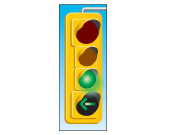9 November 2017
Row brewing over George Street bike ban
Bikes are to be banned from George Street, one of Sydney’s key bike commuter routes.
It appears that the ban has been plotted by the State Government under the cover of its light rail project.
The ban will apply from next year when the government introduces what it describes as a "pedestrian zone” along the tram street.
Cars, trucks and motorcycles, will all still be permitted in the street. Only bikes will be banned.
The government says residents, workers and businesses need to be able to get to their premises along the street, so they will be allowed in and out – if they have a motor vehicle.
However, if you are a resident, worker or delivery person on a bike, you will be banned and could face fines.
It is evident from the previously full bike racks that line George Street, bike counts and the busy end of trip facilities in the precinct, that bikes are important to the street’s commercial health.
The bike ban also undermines actions of the freight division of Transport for NSW, who have provided a courier hub to transfer items from vans to bike couriers to deliver to city businesses more quickly and efficiently.
With a bike ban in place, these deliveries will still need to be made by van on George Street, creating spaces where delivery drivers continue to mix in pedestrian spaces.
Transport for NSW’s own
CBD and South East Light Rail Project Pedestrian and Cyclist Network and Facilities strategy states that the project should consider
“encouraging an increased pedestrian and cycle mode share”.
And yet opposite is enacted within the same document: “
George Street will no longer be available [for bicycle riders] after completion and during operation of the CSELR.”
Consideration is made of ‘desire lines’ of optimal pedestrian movements, which is appropriate for an urban traffic plan, but the desire lines of bike riders is entirely overlooked.
Without George Street, bike access to a large sector of the CBD is discouraged and limited due to poor connections.
More Sydney streets face bike bans
George Street however, is not the only street facing bike bans.
Other established riding routes along the light rail corridor see bikes excluded, or de-priotised without the provision of viable alternatives.
Devonshire Street, for instance, “
would no longer be designated as a cycle route following the completion of the CSELR project.”
Devonshire Street is the best connection for people who ride bikes between Bourke Street, Moore Park and Central Station and the suggested alternative route is in no way equivalent in connectivity, quality or directness.
Reasons for bike exclusion
The reason given for excluding bike riders from George Street and Devonshire Street is that,
“there is a perceived safety risk with cyclists riding along the track alignment”.
This is clearly nonsense as bicycles will still be allowed along other sections of George Street where there will be tracks, as well as on Chalmers Street.
The NSW government even proposes a bike route along tram tracks on narrow Hay Street.
Likewise, statements that claim there is currently no significant cyclist traffic along George Street, and that there are safe alternatives to George Street, are unfounded.
If the light rail corridor cannot accommodate bike riders and displaces established and significant bike riding routes, at the very least, alternative quality bike routes must be established as part of the Light Rail Project. [...]









